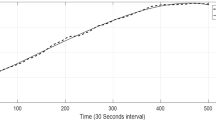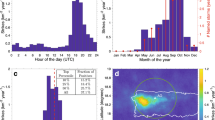Abstract
THE details of the structure of the oscillatory portion of the wave-form of an atmospheric have been the subject of several investigations1. Prof. T. H. Laby and his co-workers of the Australian Radio Research Board have made the remarkable suggestion that the observed complicated structure can be interpreted in terms of a series of reflections from an ionospheric layer of the simpler primary disturbance due to lightning. Their analysis places this height at 59–88 km.
This is a preview of subscription content, access via your institution
Access options
Subscribe to this journal
Receive 51 print issues and online access
$199.00 per year
only $3.90 per issue
Buy this article
- Purchase on Springer Link
- Instant access to full article PDF
Prices may be subject to local taxes which are calculated during checkout
Similar content being viewed by others
References
Watson Watt, R. A., Herd, F. F., and Lutkin, F. E., Proc. Roy. Soc., A, 162, 267 (1937). Appleton, E. V., and Chapman, F. W., Proc. Roy. Soc., A, 158, 1 (1937). Laby, T. H., Nicholls, F. G., Nickson, A., and Webster, H., NATURE, 139, 837 (1937). Laby, T. H., Nicholls, F. G., Nickson, A. F. B., and McNeill, J. J., NATURE, 142, 353 (1938).
Author information
Authors and Affiliations
Rights and permissions
About this article
Cite this article
SCHONLAND, B., ELDER, J., VAN WYK, J. et al. Reflection of Atmospherics from the Ionosphere. Nature 143, 893–894 (1939). https://doi.org/10.1038/143893a0
Issue Date:
DOI: https://doi.org/10.1038/143893a0
This article is cited by
-
Propagation normale et propagation guidée d'un atmosphérique dans l'atmosphère
Annales Des Télécommunications (1946)
-
Wave form of Atmospherics
Nature (1941)
Comments
By submitting a comment you agree to abide by our Terms and Community Guidelines. If you find something abusive or that does not comply with our terms or guidelines please flag it as inappropriate.



